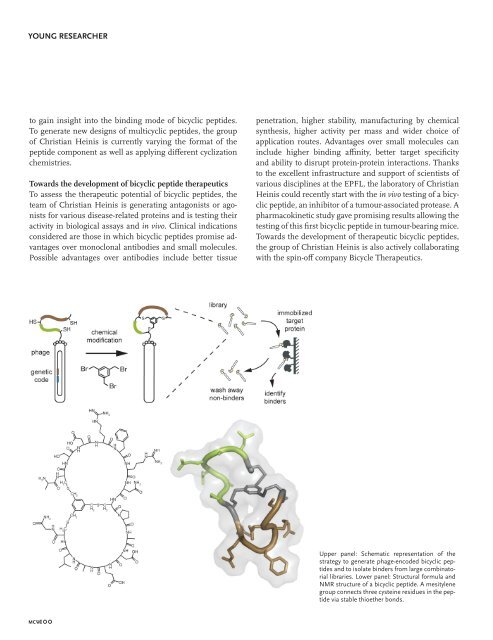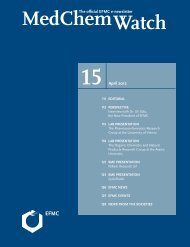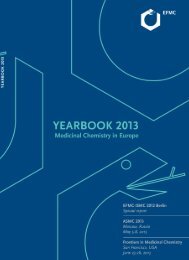Create successful ePaper yourself
Turn your PDF publications into a flip-book with our unique Google optimized e-Paper software.
YOUNG RESEARCHER<br />
to gain insight into the binding mode of bicyclic peptides.<br />
To generate new designs of multicyclic peptides, the group<br />
of Christian Heinis is currently varying the format of the<br />
peptide component as well as applying different cyclization<br />
<strong>chem</strong>istries.<br />
Towards the development of bicyclic peptide therapeutics<br />
To assess the therapeutic potential of bicyclic peptides, the<br />
team of Christian Heinis is generating antagonists or agonists<br />
for various disease-related proteins and is testing their<br />
activity in biological assays and in vivo. Clinical indications<br />
considered are those in which bicyclic peptides promise advantages<br />
over monoclonal antibodies and small molecules.<br />
Possible advantages over antibodies include better tissue<br />
MCW100<br />
penetration, higher stability, manufacturing by <strong>chem</strong>ical<br />
synthesis, higher activity per mass and wider choice of<br />
application routes. Advantages over small molecules can<br />
include higher binding affinity, better target specificity<br />
and ability to disrupt protein-protein interactions. Thanks<br />
to the excellent infrastructure and support of scientists of<br />
various disciplines at the EPFL, the laboratory of Christian<br />
Heinis could recently start with the in vivo testing of a bicyclic<br />
peptide, an inhibitor of a tumour-associated protease. A<br />
pharmacokinetic study gave promising results allowing the<br />
testing of this first bicyclic peptide in tumour-bearing mice.<br />
Towards the development of therapeutic bicyclic peptides,<br />
the group of Christian Heinis is also actively collaborating<br />
with the spin-off company Bicycle Therapeutics.<br />
Upper panel: S<strong>chem</strong>atic representation of the<br />
strategy to generate phage-encoded bicyclic peptides<br />
and to isolate binders from large combinatorial<br />
libraries. Lower panel: Structural formula and<br />
NMR structure of a bicyclic peptide. A mesitylene<br />
group connects three cysteine residues in the peptide<br />
via stable thioether bonds.





